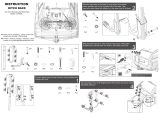
6
CroozerKid-ENG-10/12
Safety Guidelines
Legal requirements for transporting children
Be sure to observe all laws that apply to the transport
of children in child trailers. Some countries prohibit the
transport of children in child trailers, and others prescribe
certain age limits. In case of doubt, be sure to familiarise
yourself with the legal requirements of the country in which
you plan to use the Croozer Kid.
Before your rst ride...
It is vitally important that you familiarise yourself with the
Croozer Kid before you use it for transporting children.
Prior to your rst trip with passengers, Zwei plus zwei
GmbH recommends taking a practice ride with the trailer
in a calm, trafc-free area; load the trailer with cargo of
approximately the same weight as the child or children you
will be transporting, for example, by strapping a loaded
backpack/rucksack into the child seat. This is a great way
to acquaint yourself with the handling of the bicycle and
the dimensions of the trailer.
Buckle up!
Children riding in the Croozer Kid must be strapped into
the safety harnesses at all times. Follow the instructions
provided in this manual for fastening the safety harnesses
correctly. Children who are not properly secured in a safety
harness could sustain life-threatening injuries in the case
of accidents or sudden braking.
Looking after child passengers
Never leave children in the Croozer Kid unattended. It is
the user’s responsibility to ensure that the ventilation and
temperature in the trailer is comfortable for the passengers
at all times. Check on the passengers frequently to make
sure they are safe and comfortable in the Croozer Kid.
Keep handlebar attached
Leave the handlebar attached to the Croozer Kid at all
times. In the event of an accident, it acts as a roll bar,
protecting the passengers.
Crushing hazard
When folding and unfolding the Croozer Kid, keep ngers
and hands clear of all possible pinch points (e.g. movable
frame parts and locking mechanisms).
Pulling the Croozer Kid as a Bicycle Trailer
Before each ride, check the following:
• Are the wheels securely attached?
• Are the locking mechanisms on both vertical frame
tubes securely engaged?
• Are all security pins correctly inserted and locked?
Check that none of the security pins are hanging freely
from their straps.
• Check tyre pressure prior to each ride. We recom-
mended riding with a tyre pressure of 1.5 to 2.5 bar
(22-36 P.S.I.). Never use compressed air, e.g. from a
gas/petrol station, to ll your tyres. The rapid airow
and high pressure can overinate the tyres, causing the
tube and/or tyre to burst.
Using the parking brake
When loading or unloading children, or when passengers
are getting in or out of the trailer, the parking brake of the
Croozer Kid must be engaged to prevent unintentional
rolling.
Turning
Always reduce your speed to a walking pace when mak-
ing turns with the Bicycle Trailer. Keep in mind that riding
speed is often underestimated, especially on bikes with
electric assist. When turning at high speeds, the increased
centrifugal force can cause the trailer to skid or tip over
and result in accidents with serious injury or death.
Riding downhill
Always reduce your speed when riding downhill. Riding at
excessive speeds can cause the trailer to skid and result in
accidents with serious injury or death.
Riding over curbs or uneven surfaces
Riding over a curb or other obstacle with only one wheel
of the trailer could cause the trailer to tip over, resulting in
accidents with serious injury or death. Empty trailers are
especially susceptible to tipping. Therefore, if you have to
ride over a curb or similar obstruction, always use extreme
caution and ride at very low speeds. Never use the Croo-
zer Kid on stairs or escalators.
Risk of injury from rotating parts
Always make sure that the child cannot reach the wheels
of the Croozer Kid or the rear wheel of the towing bicycle.
Touching wheels that are in motion could result in serious
injuries.
Close the cover
When riding with the trailer, always close the mesh cover –
or both covers – in order to protect the passenger from y-
ing insects or small stones thrown up from the rear wheel
of the towing bicycle, which can result in serious injuries
for the passengers.
The vehicle’s plastic windows and fabric cover offer only
minimal protection against UV rays. Take the same pre-
cautions as you would outdoors to protect your child’s skin
from the harmful rays of the sun.
Being visible to others
Never use your Croozer Kid as a Bicycle Trailer without
the safety ag mounted. The safety ag makes it easier for
other road users to see you.
Carrying cargo
Never transport cargo items together with children on the
seat or in the foot area. Cargo must be well secured in the
rear cargo compartment to ensure that it cannot shift duri-
ng transport. Loose cargo and overloading can change the
handling of the Croozer Kid, making the vehicle more dif-
cult to control. Furthermore, cargo items can fall against
the seatback and injure the passenger. Never transport
animals together with children in the Croozer Kid.
Never attach loads, such as children’s vehicles or bags
(other than the Handlebar Console available as an ac-
cessory), to the handlebar of the Croozer Kid, as doing
so compromises the stability and handling of the vehicle,
which can result in accidents with serious injury or death.



























